A tradition is a system of beliefs or behaviors passed down through generations, rooted in the past. In the Philippines, these practices reflect a rich blend of indigenous customs and colonial influences. From early artifacts to modern practices, Filipino culture has evolved while preserving its unique identity.
One notable example is the 1895 bronze tympanum, housed at the Library of Congress. This artifact symbolizes the preservation of cultural history and the transmission of values across generations. Such pieces highlight the importance of understanding how traditions shape a society.
Filipino folk traditions emerged within a broader cultural context, influenced by both local practices and external forces. The arrival of American colonialism introduced new dynamics, further shaping the evolution of these customs. This article explores how these influences intertwined to create the vibrant culture we see today.
Key Takeaways
- A tradition is a system of beliefs or behaviors passed down through generations.
- Filipino culture blends indigenous customs with colonial influences.
- Artifacts like the bronze tympanum highlight cultural preservation.
- American colonialism played a significant role in shaping Filipino traditions.
- Understanding history helps us appreciate the evolution of cultural practices.
Introduction: Filipino Folk Traditions and American Influence
The interplay between Filipino customs and American colonialism created a unique cultural landscape. This blending of influences shaped the way stories, practices, and values were passed down through generations. One of the most powerful tools for preserving these narratives has been oral storytelling.
In Filipino society, storytelling serves as both entertainment and education. It connects people to their roots, teaching lessons and sharing history. For example, elders often recount tales to younger members of the community, ensuring that cultural knowledge remains alive.
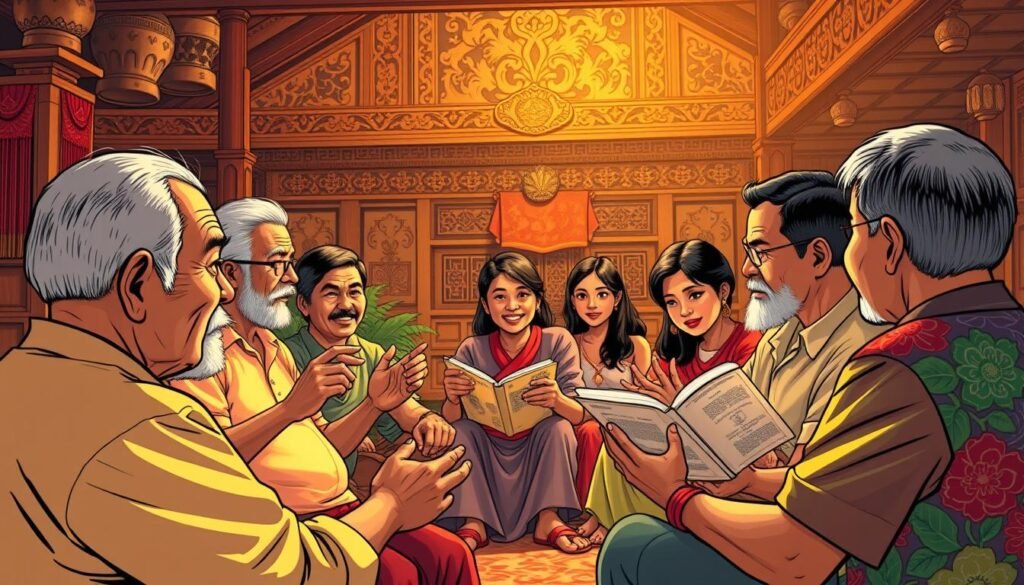
Specific groups, such as indigenous communities, have played a vital role in maintaining these practices. Despite external pressures, they’ve preserved their stories through rituals and communal gatherings. This resilience highlights the importance of individuals and leaders in safeguarding cultural identity.
During the American colonial period, new ideas and practices were introduced. However, Filipinos found ways to adapt while keeping their core values intact. This balance between change and continuity is a testament to the strength of Filipino culture.
As we explore this topic further, we’ll see how storytelling and community efforts have shaped the cultural fabric of the Philippines. These practices not only reflect the past but also guide the future.
Historical Background of Philippine Traditions
Early interactions between native Filipinos and colonial powers shaped the nation’s cultural identity. These encounters, rooted in the past, laid the groundwork for the Philippines’ unique blend of indigenous and foreign influences. From myths to rituals, the country’s cultural evolution reflects its historical encounters.

Colonial Legacy and Early Cultural Interactions
The Philippines’ colonial past began with Spanish rule and continued under American governance. These periods introduced new ideas, practices, and systems that influenced native customs. Despite these changes, Filipinos adapted while preserving their core values.
One significant impact was the blending of foreign and local narratives. For example, indigenous myths were often reinterpreted to align with colonial ideologies. This fusion created a rich tapestry of stories that continue to resonate across generations.
Foundational Myths and Rituals
Filipino culture is deeply rooted in its myths and legends. These stories, passed down through generations, serve as a bridge between the past and present. They often convey moral lessons and societal values, reinforcing community bonds.
Ritual practices play a crucial role in preserving these narratives. From harvest ceremonies to religious festivals, these events celebrate cultural identity and ensure the continuity of shared knowledge. Language has also been a vital medium, with over 70 dialects contributing to the richness of these traditions.
Oral transmission remains a cornerstone of Filipino culture. Elders recount tales to younger members, ensuring that the essence of these stories endures. This generational exchange highlights the resilience and adaptability of Filipino traditions.
Understanding Traditions: Their Role in Filipino Culture
Filipino culture thrives on the connection between art, family, and shared values. These elements form the foundation of cultural traditions that define the nation’s identity. From storytelling to festivals, these practices are woven into the fabric of everyday life.
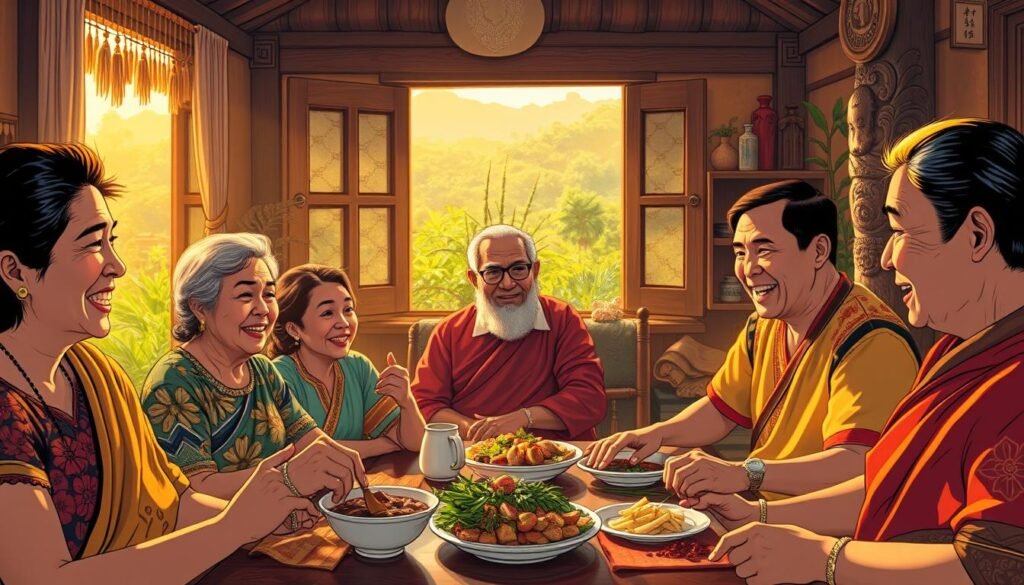
Cultural Expressions and Folklore
Art and folklore are powerful tools for expressing communal values. Traditional forms like weaving, pottery, and dance tell stories of the past. These practices are not just creative outlets but also ways to preserve history and teach lessons.
For example, the art of banig weaving showcases intricate patterns passed down through generations. Similarly, folk dances like Tinikling reflect the harmony between people and nature. These expressions highlight the creativity and resilience of Filipino culture.
Preservation Across Generations
Family plays a central role in keeping cultural traditions alive. Elders pass down knowledge through storytelling, rituals, and daily practices. This ensures that values and customs remain relevant in modern life.
One notable practice is the pagmamano, a gesture of respect where younger family members touch the hands of elders to their foreheads. This simple act reinforces the importance of respect and family bonds.
| Traditional Art Form | Family Practice | Cultural Significance |
|---|---|---|
| Banig Weaving | Pagmamano | Preserves history and teaches respect |
| Tinikling Dance | Storytelling | Celebrates harmony and community |
| Pottery | Festival Participation | Strengthens family and communal ties |
These practices not only preserve cultural traditions but also foster a sense of belonging. They remind Filipinos of their roots while adapting to the changing ways of the world.
American Colonial Impact on Filipino Society and Practices
The American colonial period brought significant changes to the Philippines, reshaping its social and political systems. This era introduced reforms that altered the country’s governance, education, and public health. These changes became a part of the evolving Filipino identity, blending old and new ideas.
One major reform was the establishment of the Philippine Assembly in 1907, the first elective legislative body in Southeast Asia. This marked a shift toward democratic governance, integrating American political systems into Filipino society. The Assembly allowed Filipinos to participate in their governance, fostering a sense of national identity.
Education also saw dramatic improvements. By the 1930s, nearly 50% of Filipinos could read and write, and English became widely spoken. This literacy boost helped unify the country and opened doors to global communication. Public health reforms, like the creation of urban parks, improved community well-being and cohesion.
However, these changes sometimes clashed with indigenous practices. For example, the introduction of American agricultural policies transformed the economy but disrupted traditional farming methods. Despite this, Filipinos adapted, merging new ideas with their cultural heritage.
To learn more about the lasting effects of colonialism, visit this detailed analysis.
Political and Social Reforms
American rule introduced policies that restructured the Philippines’ societal frameworks. The Tydings-McDuffie Act of 1934, for instance, laid the groundwork for independence, blending Filipino aspirations with American governance systems. This act allowed Filipinos to draft their own constitution, fostering a sense of autonomy.
Public health initiatives, like those during the 1902 cholera epidemic, highlighted the importance of modern medical practices. These reforms became a part of daily life, improving the overall quality of life for many Filipinos.
Despite these advancements, some policies, like the Payne-Aldrich Tariff Act, limited industrial growth, creating economic challenges. These reforms shaped the country’s identity, blending resilience with adaptation.
Storytelling: The Oral Transmission of Cultural Heritage
Storytelling has always been a bridge between generations, preserving cultural heritage through spoken words. Across the globe, communities have relied on this timeless method to pass down their history, values, and identity. From chants to dances, storytelling takes many forms, each reflecting the unique spirit of its people.
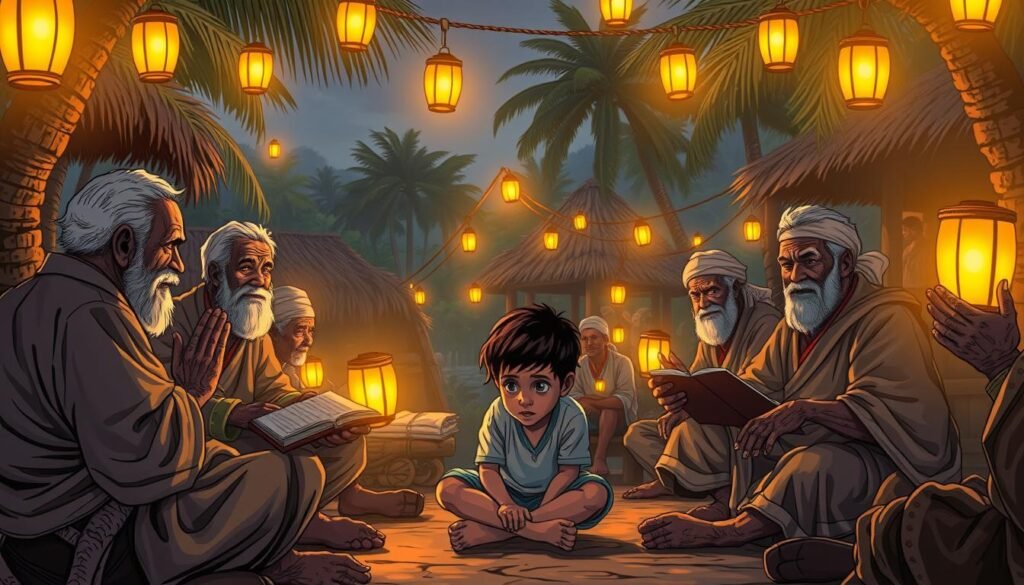
Traditional Methods and Modern Adaptations
Traditional storytelling often involves performances that engage the senses. In Native Hawaiian culture, the term “moʻolelo” signifies not just a story but also history, legend, and tradition. Storytellers, known as kupuna, were honored members of society, ensuring the continuity of their narratives.
In Western Africa, griots play a similar role. These storytellers are historians, genealogists, and ambassadors, preserving their community’s legacy through songs and chants. Their performances often occur during communal gatherings, reinforcing the bond among members.
Lessons from Global Storytelling Traditions
Storytelling is not confined to one culture. In Ireland, the seanchaí traveled between villages, sharing tales that connected communities. Today, there’s a resurgence of interest in these practices, highlighting their enduring relevance.
Similarly, Aboriginal Australians use songlines to navigate their land. These songs serve as maps, blending geography, spirituality, and history. Such examples show how storytelling makes a difference in preserving cultural memories.
“Storytelling is the most powerful way to put ideas into the world.”
| Culture | Storytelling Method | Key Role |
|---|---|---|
| Native Hawaiian | Moʻolelo (chants and legends) | Preserves history and identity |
| Western African | Griot performances | Acts as historian and ambassador |
| Aboriginal Australian | Songlines | Combines geography and spirituality |
Communal celebrations play a vital role in keeping these traditions alive. Whether it’s a festival or a family gathering, storytelling fosters a sense of belonging. It ensures that cultural values remain relevant, even in a rapidly changing world.
From dance to song, storytelling continues to mark a difference in how communities preserve their heritage. It’s a testament to the power of shared narratives in shaping our collective identity.
Role of Rituals and Family Celebrations in Traditions
Rituals and family celebrations serve as the heartbeat of Filipino culture, connecting generations through shared experiences. These practices are not just events but meaningful expressions of identity and values. They strengthen bonds and ensure the continuity of cultural heritage.
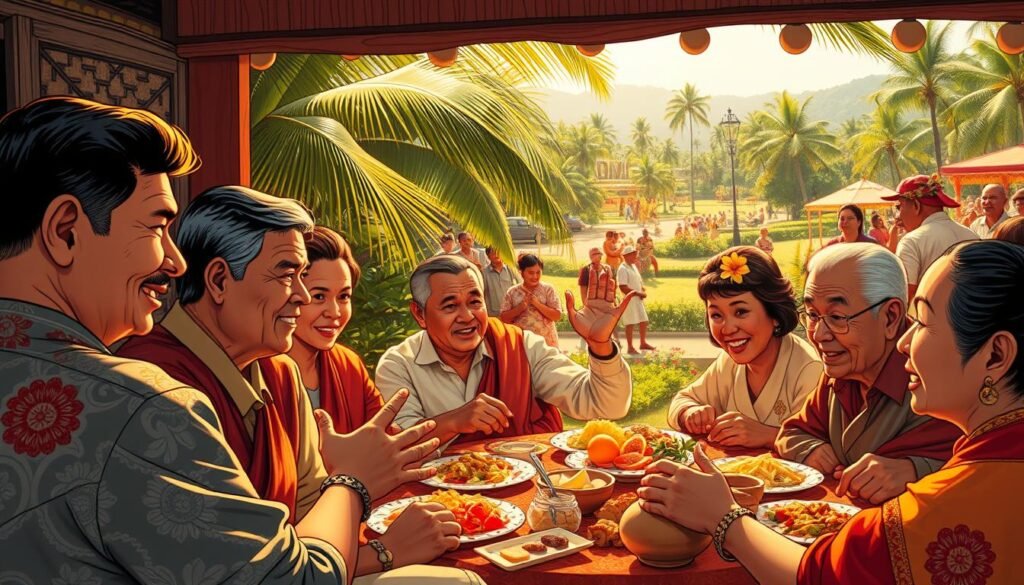
Community Ceremonies and Social Gatherings
Community ceremonies play a crucial role in binding people together. Whether it’s a harvest festival or a religious event, these gatherings reinforce shared values and long-held traditions. They provide a space for storytelling, work collaboration, and collective celebration.
For example, the Pahiyas Festival in Lucban showcases the community’s gratitude for a bountiful harvest. Homes are adorned with colorful decorations made from agricultural material, symbolizing abundance and unity. Such events highlight the importance of communal efforts in preserving culture.
The Significance of Family Rituals
Family rituals are equally vital in shaping the upbringing of a child. From simple daily routines to elaborate celebrations, these practices teach values, foster security, and create lasting memories. They help children navigate life’s changes with confidence.
One common ritual is the pagmamano, where younger family members show respect to elders by touching their hands to their foreheads. This simple act reinforces the importance of respect and family bonds. Learn more about the role of family rituals in fostering connections.
Women often take the lead in organizing these events, ensuring that every detail reflects cultural significance. Their work in preserving traditions is a testament to their dedication and leadership within the family and community.
Material objects used in rituals, such as heirlooms or symbolic items, also play a key role. These objects carry stories and meanings that are passed down through generations. They serve as tangible reminders of the family’s history and values.
From birth to adulthood, Filipino ceremonies mark life’s milestones with deep cultural significance. These practices not only preserve the past but also guide the future, ensuring that the essence of Filipino culture remains alive.
Invention and Preservation of Cultural Practices
Cultural practices often evolve through a blend of authenticity and invention, shaping the identity of a society. This dynamic process highlights how traditions are both preserved and reinvented over time. Understanding this balance is key to appreciating the richness of cultural heritage.
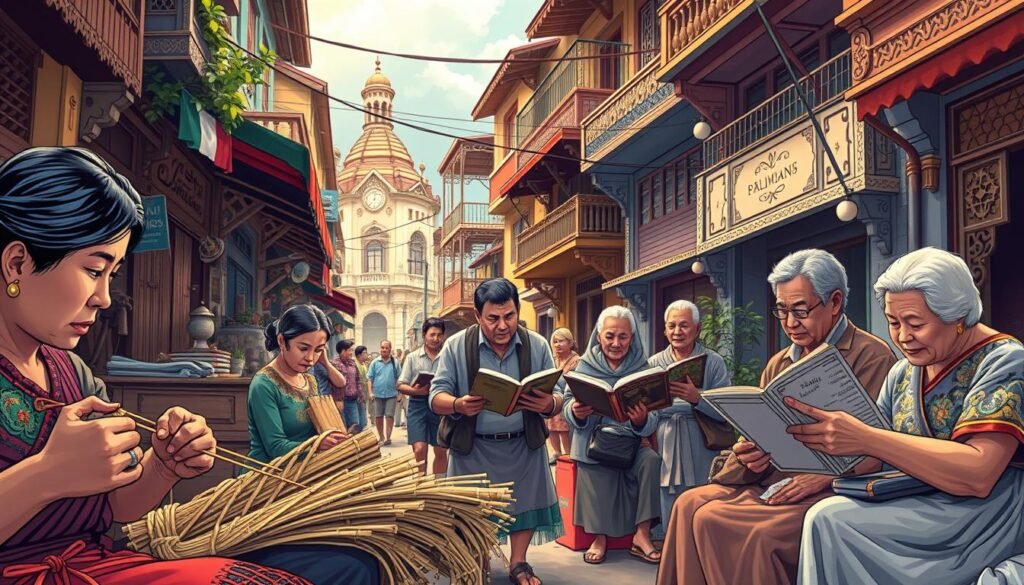
Authentic Traditions vs. Invented Practices
The concept of the “invention of tradition” refers to practices that are introduced with an implied historical legacy, even if they are relatively new. For example, colonial authorities often created traditions to legitimize their power, blending local customs with foreign influences. These invented practices sometimes overshadowed authentic cultural expressions.
Authentic traditions, on the other hand, are deeply rooted in a community’s history and values. They are passed down through generations, often through oral storytelling or ritual practices. The objects used in these traditions, such as heirlooms or symbolic items, carry significant meaning and help preserve cultural identity.
One notable example of invented tradition is the fictional character Paul Bunyan, whose stories were transformed by mass culture in the 20th century. This contrasts with authentic folklore, which often includes technical jargon and complex narratives that reflect the community’s lived experiences.
Material Objects and Forms in Cultural Preservation
Material objects play a crucial role in preserving cultural heritage. From traditional crafts to ceremonial items, these forms serve as tangible reminders of a community’s history. For instance, the intricate patterns of banig weaving in the Philippines are not just artistic expressions but also a means of passing down knowledge.
Technology has also become a vital means of preserving cultural practices. Tools like 3D modeling and augmented reality allow communities to document and share their heritage in innovative ways. These technologies ensure that cultural narratives remain accessible to future generations.
“The preservation of cultural heritage is not just about protecting the past but also about shaping the future.”
Maintaining Authenticity in a Changing World
As societies evolve, so do their cultural practices. The challenge lies in maintaining authenticity while adapting to contemporary influences. Communities must find ways to preserve the core aspects of their traditions while embracing change.
For example, the pagmamano gesture in Filipino culture remains a powerful symbol of respect, even as modern lifestyles influence family dynamics. Similarly, festivals like the Pahiyas continue to celebrate communal values, blending traditional and modern elements.
- Define the concept of “invention of tradition” and its implications.
- Contrast authentic practices with deliberately invented ones.
- Analyze the role of material objects in preserving cultural heritage.
- Explore how technology aids in the preservation of traditions.
- Discuss the importance of authenticity in cultural narratives.
To learn more about the preservation of cultural heritage, visit this detailed resource. Understanding these processes helps us appreciate the resilience and adaptability of cultural practices in a globalized world.
Cultural Adaptation in a Globalized Society
In today’s interconnected world, cultural practices are constantly evolving to adapt to modern influences. Globalization has brought people closer, creating a melting pot of ideas and customs. This has led to the transformation of traditional practices over time, blending ancient customs with contemporary lifestyles.
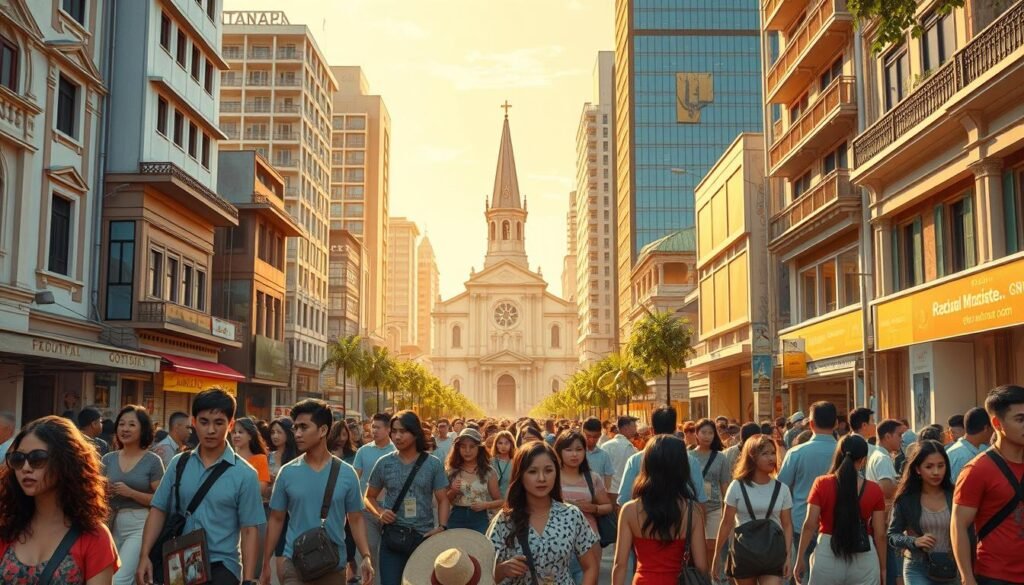
Modern Influences and Evolving Practices
The rise of industrialization and technology has significantly impacted cultural practices. For example, Filipino folk traditions have been revitalized through modern adaptations. Festivals like the Pahiyas now incorporate digital elements, attracting a global audience while preserving their core values.
Globalization has also introduced new challenges. Local practices often face competition from global trends, leading to a delicate balance between preservation and innovation. Despite this, many communities have found ways to adapt, ensuring their cultural heritage remains relevant in a rapidly changing world.
“Cultural adaptation is not about losing identity but about finding new ways to express it.”
The Role of Time in Cultural Preservation
The passage of time plays a crucial role in shaping cultural practices. As societies evolve, so do their traditions. This continuous interplay between the past and present ensures that cultural values are passed down to future generations. For instance, the pagmamano gesture in Filipino culture remains a powerful symbol of respect, even as modern lifestyles influence family dynamics.
To better understand the stages of cultural adaptation, explore this detailed guide. It highlights the importance of preparation, social support, and personal well-being in navigating cultural changes.
- Globalization has reshaped traditional practices over time.
- Modern adaptations have revitalized Filipino folk traditions.
- The balance between ancient customs and contemporary lifestyles is key to cultural preservation.
- Time ensures the continuity of cultural values in a globalized world.
As the world continues to evolve, cultural adaptation remains a vital process. It allows communities to preserve their heritage while embracing change, ensuring that their values endure for generations to come.
Interplay Between Oral Tradition and Written Documentation
The shift from oral to written documentation marks a pivotal moment in cultural preservation. For centuries, communities relied on spoken words to pass down stories, values, and history. However, the introduction of writing transformed how narratives were recorded and shared, creating a lasting impact on cultural identity.
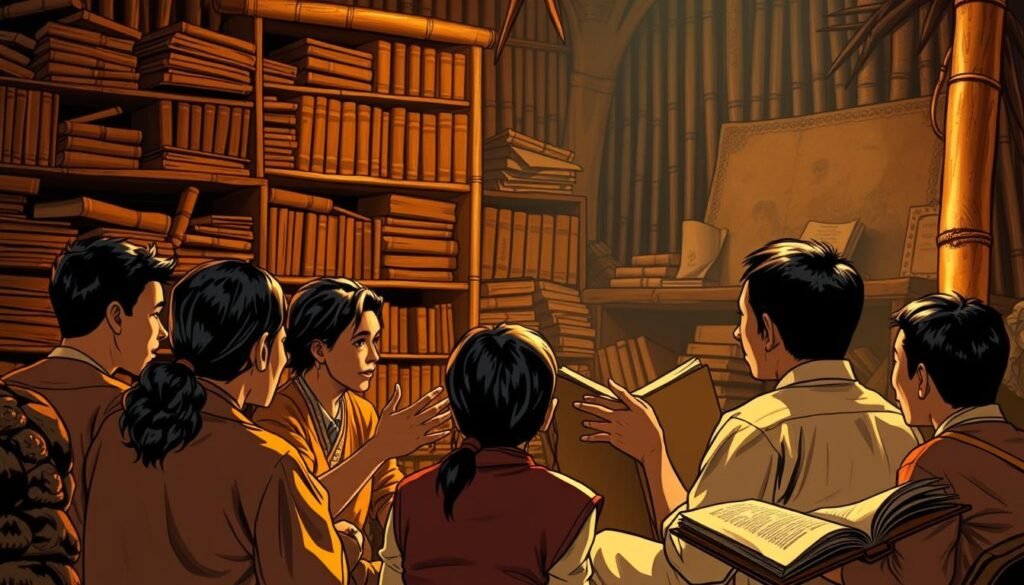
Transition from Oral to Written Forms
Historically, oral traditions were the primary means of preserving knowledge. Elders and storytellers played a crucial role in ensuring that cultural narratives were passed down through generations. With the advent of writing, these stories began to be recorded, offering a more permanent way to safeguard them.
Religious institutions were among the first to adopt written forms. For example, sacred texts like the Bible and the Vedas were transcribed to preserve their teachings. This transition allowed for wider dissemination of beliefs and ensured their continuity across time and place.
Maintaining Authentic Narratives
Written documentation brought challenges in maintaining the authenticity of oral stories. Oral traditions often allowed for flexibility, with storytellers adapting narratives to suit their audience. Written records, on the other hand, fixed these stories in a specific form, sometimes altering their original essence.
Despite this, written forms have contributed to preserving the core values of cultural narratives. For instance, Filipino epics like the Hudhud were transcribed, ensuring their survival even as oral practices declined. This blend of oral and written methods highlights the resilience of cultural beliefs.
Religious institutions have played a significant role in this process. By documenting rituals and teachings, they have safeguarded cultural narratives that might otherwise have been lost. This dual approach—oral and written—has ensured that traditions remain relevant in a changing world.
“The preservation of cultural heritage is not just about protecting the past but also about shaping the future.”
Examples like the Hudhud and the Vedas show how traditions can thrive in both oral and written forms. These practices have ensured that cultural values endure, even as societies evolve. To learn more about the significance of oral tradition, explore this detailed resource.
Reconciling the fluidity of oral storytelling with the permanence of written records remains a challenge. However, this interplay has enriched cultural preservation, offering multiple ways to safeguard our shared heritage. As we continue to adapt, the balance between these forms will remain a cornerstone of cultural identity.
Analyzing Transformative Effects on Filipino Society
Filipino society has undergone profound transformations over the centuries, shaped by both internal and external forces. From colonial rule to modern globalization, these changes have left a lasting impact on cultural narratives and practices. Understanding this evolution helps us appreciate the resilience of Filipino culture.
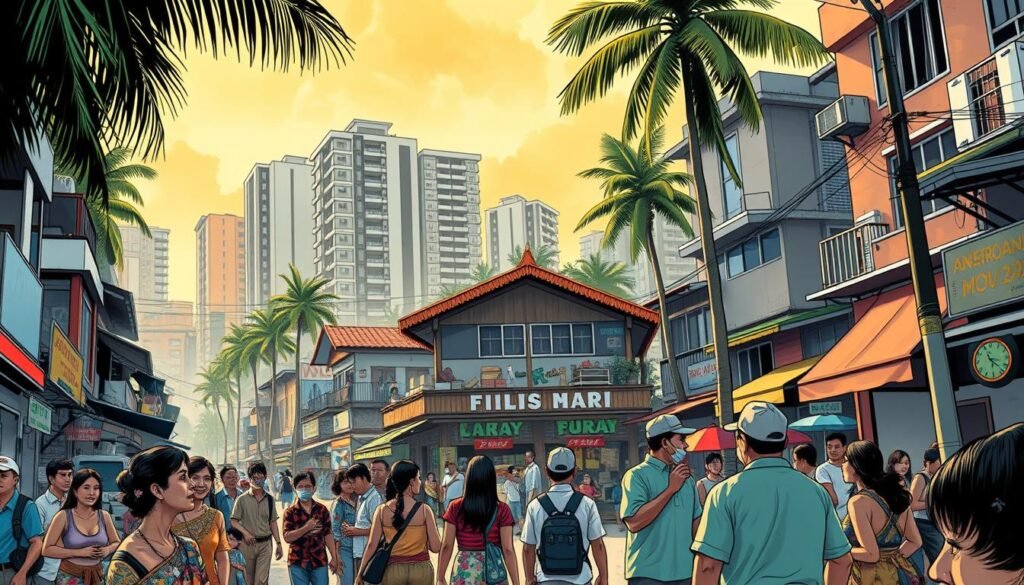
Social Change and Cultural Resilience
Historical and colonial transformations have significantly influenced contemporary Filipino society. The introduction of new governance systems, educational reforms, and economic policies during the American colonial period reshaped societal structures. Despite these changes, many cultural practices have persisted, demonstrating the adaptability of Filipino traditions.
For example, the pagmamano gesture, a symbol of respect, remains a vital part of Filipino family life. This simple act encapsulates the word of respect, a core value that has endured through centuries of social and political change. Such practices highlight the resilience of cultural identity in the face of external pressures.
The need for cultural preservation has become increasingly important in a rapidly modernizing world. As globalization introduces new influences, communities must find ways to adapt while maintaining their heritage. This balance ensures that cultural narratives remain relevant for future generations.
| Historical Period | Key Changes | Cultural Resilience |
|---|---|---|
| Spanish Colonial Era | Introduction of Christianity | Blending of religious and indigenous practices |
| American Colonial Period | Educational and political reforms | Adaptation of democratic values |
| Modern Globalization | Economic and technological advancements | Revitalization of traditional festivals |
Over the century, Filipino society has faced numerous challenges, from colonial rule to economic inequality. Yet, the ability to adapt and preserve cultural practices has been a defining feature of its resilience. For instance, the Pahiyas Festival continues to celebrate communal values, blending traditional and modern elements.
The ongoing need for cultural preservation is evident in initiatives like the Philippine Rural Development Project, which supports community-driven efforts to safeguard heritage. Such projects highlight the importance of collective action in maintaining cultural identity.
In conclusion, the transformative effects on Filipino society reflect a history of adaptation and perseverance. By understanding these changes, we can better appreciate the resilience of cultural practices that continue to shape the nation’s identity. The word of resilience, embodied in traditions like pagmamano, serves as a reminder of the enduring strength of Filipino culture.
Conclusion
The evolution of Filipino folk practices under American influence showcases a unique blend of indigenous and colonial elements. This fusion shaped a vibrant cultural identity, rooted in history yet adaptable to change. Storytelling and rituals played a vital role in preserving collective memory, ensuring values were passed down through generations.
American reforms introduced new systems, but Filipinos found ways to integrate these changes while maintaining their core heritage. The resilience of these practices highlights the strength of cultural adaptation. From family celebrations to communal gatherings, these customs remain a testament to the enduring spirit of Filipino society.
Understanding this historical interplay helps guide current efforts in cultural preservation. By reflecting on the past, we can ensure that these practices continue to thrive in a modern, globalized world. For deeper insights, explore this detailed analysis on cultural evolution.
FAQ
How did American influence shape Filipino folk traditions?
American colonial rule introduced political and social reforms that blended with local practices, creating a unique cultural fusion in the Philippines.
What role do rituals play in Filipino culture?
Rituals, such as community ceremonies and family celebrations, are vital for preserving cultural identity and fostering social bonds across generations.
How has storytelling preserved Filipino heritage?
Storytelling, both oral and written, has been a key method for passing down myths, values, and lessons, ensuring the continuity of cultural narratives.
What is the difference between authentic and invented traditions?
Authentic traditions have deep historical roots, while invented practices are often created to meet modern cultural or societal needs.
How has globalization affected Filipino cultural practices?
Globalization has introduced modern influences, leading to the adaptation and evolution of traditional practices to fit contemporary life.
Why are family celebrations significant in Filipino society?
Family celebrations strengthen familial ties, reinforce cultural values, and provide a sense of belonging within the community.
How did the transition from oral to written documentation impact Filipino traditions?
This shift helped preserve authentic narratives while allowing for broader dissemination and accessibility of cultural stories.
What lessons can be learned from global storytelling traditions?
Global storytelling highlights the universal importance of narratives in shaping identity, values, and cultural resilience.
How did American social reforms influence Filipino society?
Reforms in education, governance, and infrastructure brought significant changes, blending American ideals with local customs.
What is the significance of foundational myths in Filipino culture?
Foundational myths explain the origins of cultural practices and beliefs, providing a shared identity and understanding of the world.
Source Links
- Philippine Literature during the American Period – National Commission for Culture and the Arts
- Philippines – US Influence, Colonialism, Revolution | Britannica
- Philippine Music, A Historical Overview – National Commission for Culture and the Arts
- Culture of the Philippines
- Philippines – Culture, Diversity, Traditions | Britannica
- Culture of The Philippines – history, people, clothing, traditions, women, beliefs, food, customs, family
- History and Culture | Ateneo Global
- The Philippines: Culture and Tradition – Globalization Partners International
- 11 Things You Should Know About Filipino Culture
- No title found
- The American Colonial Period: Shaping Modern Philippine Society – Pinas Culture
- The legacy of American imperialism in the Philippines: From colonisation to modern-day neocolonialism – Honi Soit
- Storytelling and Cultural Traditions
- Oral tradition | Storytelling, Cultural Preservation & Memory | Britannica
- 5.3 Traditions and Rituals
- Family routines and rituals may improve family relationships and health
- Invented tradition
- Technologies for the Preservation of Cultural Heritage—A Systematic Review of the Literature
- Tradition and invention: The bifocal stance theory of cultural evolution | Behavioral and Brain Sciences | Cambridge Core
- Cultural globalization | Pros, Cons, Examples, Impact, & Factors | Britannica
- Importance of Cultural Adaptation in Unlocking New Markets
- No title found
- Oral literature | History, Characteristics & Types | Britannica
- Philippine Politics Under Duterte: A Midterm Assessment
- Overview
- Conclusions and future projections
- Conclusion (Chapter 29) – Understanding Early Civilizations

